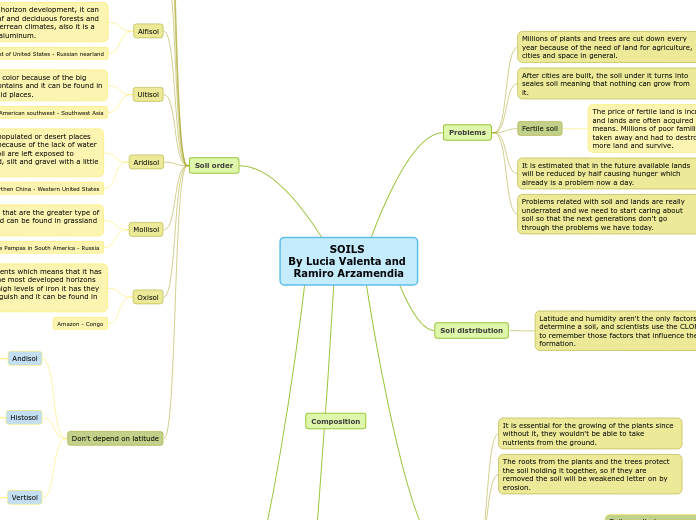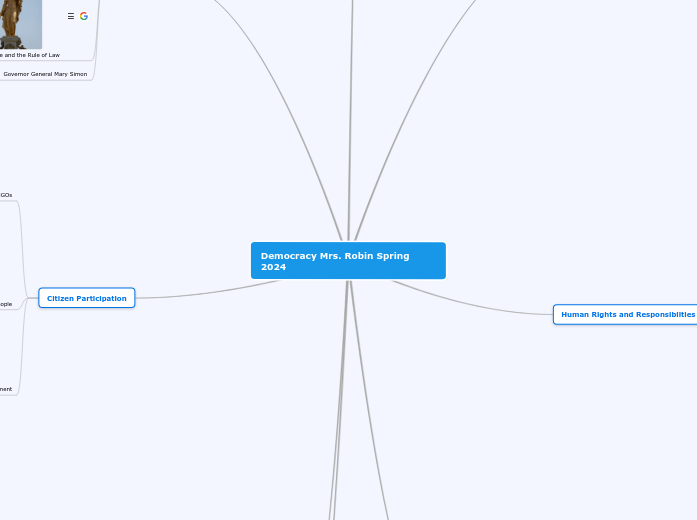Composition
SOILS
By Lucia Valenta and
Ramiro Arzamendia
clay - sand - silt
How do they variate ?
If a soil has more silt, the soil will have characteristics of both sand and clay.
If a soil has more sand, it will be worse at holding water but it will be easier for plants to grow.
If a soil has more clay, it will retain more water but because of the amount of clay the plants will have problems to grow.
If clay, sand and silt are combinated, they create loam which is said to be the best type of soil when it comes to growing plants.
Depending on the different types of particles the properties of the soil changes and they can be determined by a graph that is based on soil composition.
Size
Clay ( 0.002 cm )
Silt ( 0.05 cm )
Sand ( 2.0 cm )
Soil structure
Soil settles on top of the bedrock and within time it forms layers called horizons. The process of the formation of horizons takes thousands of years because first, rocks have to be weathered and moved by erosion.
Horizons
In some cases, there's lots of soil leaching which creates an eve horizon. This horizon is thin and made of deposited sand and silt while clay goes down to B horizon.
R Horizon
The R Horizon is just rocks.
C Horizon
The C Horizon is where the bedrock is slowly degrading into soil, mostly it is gravel and rocks with little soil.
B Horizon
The B Horizon is the farthest plant roots can go.
A Horizon
The A Horizon is where the actual surface soil is located, also because the soil organisms live there it can be called biomantle.
O Horizon
The O Horizon is where the organic matter and dead plant matter called detritus is located.
Soil order
Don't depend on latitude
Vertisol
India - Sudan
Vertisols are soils with a high clay content and prone to dry out which causes the ground to dry and then split. Due to this, the wind will blow the soil on the top into the crevices which causes the soil layers to invert and prevent horizons from forming.
Histosol
Canada - river deltas
Histosols are wetland soils, which means that they have water, also they can contain peat and organic matter. Due to the accumulation of organic matter, they can be acid and unstable to build in.
Andisol
Volcanic Andes mountains - Volcanic islands of Hawaii \ Japan
Andisols are volcanic soils rich in nutrients
Oxisol
Amazon - Congo
Oxisol is low in nutrients which means that it has low fertility, it has the most developed horizons but because of the high levels of iron it has they are difficult to distinguish and it can be found in rainforests soil.
Mollisol
American midwest - The Pampas in South America - Russia
Mollisol are dark soils that are the greater type of soil for agriculture and can be found in grassland regions.
Aridisol
Arabia - Australia - Northen China - Western United States
Aridisol is located in populated or desert places with little water and because of the lack of water the particles of the soil are left exposed to erosion and only sand, silt and gravel with a little soil.
Ultisol
American southwest - Southwest Asia
Ultisol has a reddish color because of the big amounts of iron it contains and it can be found in subtropical and humid places.
Alfisol
East coast of United States - Russian nearland
Alfisol has a normal horizon development, it can be found in broadleaf and deciduous forests and in places with mediterrean climates, also it is a soil rich in iron and aluminum.
Spodosol
Canadian coast east - Scandinavia
Spodosol can be found near the equator in biomes with boreal and coniferous forests, because of the needles of the pines that when they decompose they turn into acid, the ground has a really low fertility.
Gelisol
Northern Russia - Canada
Gelisol has little horizon development, is located in high latitudes or in mountain ranges and it has a permafrost so that soil does not move.
Inceptisol
Inceptisol has some slightly more developed horizons than entisol and a beginning of a B horizon.
Entisol
Entisol has no development of the soil horizons because it is a young soil and also is the most common one.
soil
In two thousand years only 10cm of fertile soil is formed.
Mostly new soils are located near the pole because poles used to be covered with glaciers in the last age, so they didn't had many time to develop.
Soil orders always have a sub-order, great group, subgroup, family and a series.
How was it formed ?
Formed by rocks decomposed by animals, plants, wind, sun and rain.
Soil wasn't always on earth but unlike rocks and water it didn't came from space, it was formed by two different processes after the earth cooled down, weathering and erosion.
Erosion is the process in which the small rocks are carried away by wind or water.
Weathering is the process where rocks are broken down into smaller ones by a chemical or physical process.
The roots from the plants and the trees protect the soil holding it together, so if they are removed the soil will be weakened letter on by erosion.
It is essential for the growing of the plants since without it, they wouldn't be able to take nutrients from the ground.
Soil distribution
Latitude and humidity aren't the only factors that determine a soil, and scientists use the CLORPT to remember those factors that influence the formation.
T
T is used for time and depends on how much time septa and into cells become developed soil orders.
P
P is used for parent material and depends on what it is parent material.
R
R is used for the change in the elevation. Histosols are in low elevations and aridisols are in high elevations.
O
O is used for organisms.
CL
CL is used for climate which includes rainfall, temperature and humidity. Also, the elevation and surrounding determine the climate.
Problems
Problems related with soil and lands are really underrated and we need to start caring about soil so that the next generations don't go through the problems we have today.
It is estimated that in the future available lands will be reduced by half causing hunger which already is a problem now a day.
Fertile soil
The price of fertile land is increasing now a day and lands are often acquired with questionable means. Millions of poor families had their land taken away and had to destroy forests to gain more land and survive.
After cities are built, the soil under it turns into seales soil meaning that nothing can grow from it.
Millions of plants and trees are cut down every year because of the need of land for agriculture, cities and space in general.









